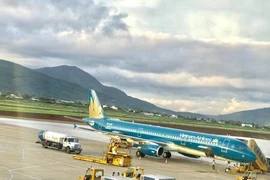Hanoi (VNS/VNA) - Increasing numbers of airlines and aircraft are putting serious pressure on Vietnam’saviation infrastructure. As competition for market share and skilled labourintensifies, the Government must take measures to ensure a fair playground andlong-term development, said industry experts and authorities.
The Civil Aviation Authority of Vietnam (CAAV) has recently approved an airoperator’s certificate (AOC) submitted by Vietstar Airlines, bringing the totalnumber of licensed air operators in the country to seven. CAAV also confirmedtwo more AOC applications submitted by Vinpearl Air and Vietravel Airlines werepending.
Vinpearl Air said it would field a fleet of six aircraft in July next yearand bring in 30 more by 2025 to fly both domestic and international routes.Vietravel Airlines said it hoped to commence operations next October with threeaircraft and planned to bring in five more by 2025.
Central Quang Nam province’s Department of Planning and Investment has also filedan application for its local airline KiteAir, who said it would begin with sixATR72 aircraft during the first quarter of next year. It aimed to operate 15ATR72 models and 12 A320/A321 models by the end of 2024.
It has placed further strain on the overloaded and overcrowded majorairports across the country such as HCM City’s Tan Son Nhat International Airport, Hanoi’s Noi Bai International Airportas well as those in the cities of Da Nang and Nha Trang.
For example, the CAAC cited the Noi Bai - Tan Son Nhat route, operated by Vietnam Airlines, Jetstar Pacific and VietJet Air,which accounted for a whopping 22.7 percent of Vietnam’s air ticket sales lastyear with flights connecting the country’s two major economic hubs reportedover 90 percent of seat capacity filled.
Terminals and runways at the two airports, as a result, are forced tooperate over capacity for a long time. To make matters worse, legal issues andcomplex aviation regulations slowed down the process to carry out much-neededrepair and upgrade work. New players had to find bases elsewhere. BambooAirways was reported to set up base at Phu Cat Airport in central Quy Nhơn province, KiteAir at ChuLai Airport in central Quang Nam province and VietravelAirlines at Phu Bai Airport in Hue city.
While routes considered profitable by air operators were over-exploited,airports in less-than-popular-destinations have seen little business withairlines claiming operations to and from such localities financiallyunsustainable.
Airlines also faced strict scrutiny in attempts to bring in additionalaircraft to their fleets. For example, CAAV reportedly turned down BambooAirways’ request to add 30 more aircraft in April citing an inadequate numberof air traffic controllers to safely monitor flights. It also curbed VinpearlAir’s plan to add 36 aircraft by 2025 to 30.
As market share is fiercely contested, air operators were forced tointroduce new and better services to lure customers. Some have started to lookfor routes outside Vietnam. Vietjet Air’s first half of the year report showedan increase of 35 percent on the number of passengers served on the airline’sinternational routes compared to last year at a total of 4 million. Theairline’s revenue from international routes outweighed its domestic counterpartfor the first time at 54 percent.
By CAAV’s estimation, by 2030 there will be 600 aircraft operating in theVietnamese aviation sector, three times the country’s current number. Asnumbers of both air operators and aircraft are set to increase in theforeseeable future, skilled manpower was also expected to be in high demand.
Offensive tactics were reported to have been used to poach technicians andpilots from competitors. The situation has gotten so severe the Governmentneeded to step in. In a recent meeting to discuss the sector’s issues, Deputy Prime Minister Truong Hoa Binh asked air operators to maintain a fairplayground and make sure workers and pilots are not overworked saying they areboth important components in the long-term development of Vietnam’s aviation industry.
By June this year, Vietnamese air operators’ fleet numbered 197, increasingby 30 compared to 2018. Vietnam Airlines, the country’s flag carrier, operated95 aircraft and employed 1,135 pilots, of which 860 were Vietnamese. VietjetAir, Jetstar Pacific and Bamboo Airways operated 65, 15 and 6 aircraft,respectively./.






























